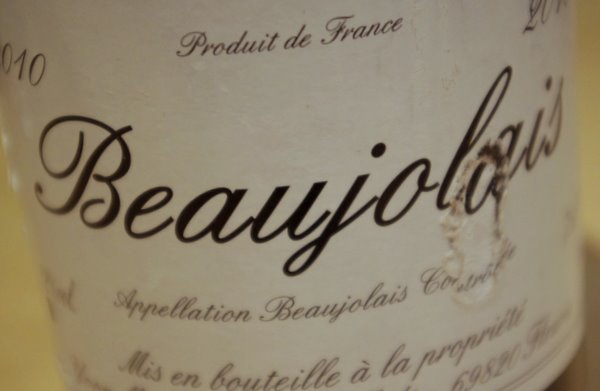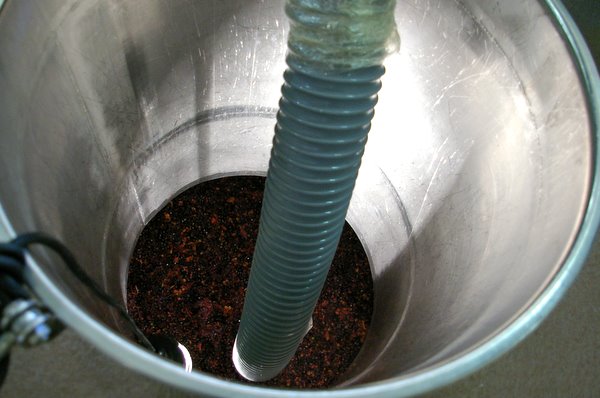|
Carbonic
maceration
A closer look at this winemaking technique

The wine world is full of terms that
people use without quite understanding just what they mean by them.
Carbonic maceration is one such term, and in this short piece Iím
going to attempt to get to grips with it, without becoming too
technical and boring. Itís a method thatís employed to make
lighter red wines with fruitier aromas, and itís strongly
associated with the Beaujolais wine region.
As with many topics in wine, the truth
isnít entirely black and white. Itís complicated. Pure carbonic
maceration is quite rare, and there are a number of variations on
the theme. But the simple version is thus:
Carbonic maceration is the process that
occurs when intact bunches of red grapes are fermented in a sealed
vessel that has first been filled with carbon dioxide. In the
absence of oxygen, these intact berries begin an intracellular
fermentation process, during which some alcohol is produced, along
with a range of other compounds that can affect wine flavour.
Once the level of alcohol reaches 2%,
which is after about a week at typical fermentation temperatures of
35 įC, the
berries begin to die. They then either release their juice, or more
typically are pressed before this happens. Then follows a normal
fermentation (carried out by yeasts), resulting in a relatively pale
coloured red wine with low tannin levels and enhanced fruity
aromatics.
So letís add some complexity to this
story. First, we need to distinguish between aerobic and anaerobic
respiration. The first is what happens in the presence of oxygen.
Cells need energy, and to get this they break down sugar using
oxygen to produce carbon dioxide, sugar and water. In the absence of
oxygen, anaerobic respiration can also take place in some cells:
yeasts do this preferentially even when oxygen is present, and the
result is that sugar is broken down to alcohol and carbon dioxide.
The cells in grapes can carry out anaerobic respiration, but they
are less able to cope with the resulting alcohol than yeasts are,
and if they do this for too long they die.

Carbonic
maceration taking place at a winery in Spain
When whole bunches of grapes are placed
in an atmosphere of carbon dioxide, they take it up and use it in
anaerobic fermentation. In this process they break down sugars, but
also malic acid, which is one of the main acids present in grapes.
This malate degradation is the most significant step taking place
during anaerobic fermentation, and itís broken down sequentially
to pyruvate, acetaldehyde and then ethanol. Typically, at a
fermentation temperature of 35 įC, half of the malic acid is degraded in
this way.
There is therefore a fall in acidity
levels that can be quite significant, with titratable acidity (TA)
declining by as much as 3.5 g/litre and pH increasing by up to 0.6 units. But
bear in mind that there would be some loss of acidity during the
malolactic fermentation that usually occurs after alcoholic
fermentation in red wines. This is where bacteria break down malic
acid to lactic acid.
During this process, polyphenols (such as
tannins and anthocyanins) migrate from the skin to the pulp (the
inside of the grapes), turning their flesh pink. Various compounds
that are important for flavour (or which are flavour precursors) are
produced. For example, extra amino acids are liberated from grape
solids, which increases the nutrient status of the juice, and opens
up the potential for these amino acids to act as flavour precursors.
The ethanol produced can esterify some grape components, and one
ester produced this way, ethyl cinnamate, gives strawberry and
raspberry aromas. Another compound that increases is benzaldehyde,
which adds cherry/kirsch aromas.
The berries eventually die when alcohol
reaches a level of 1.5Ė2.5%.
Beaujolais is traditionally associated
with carbonic maceration, but the traditional method used here
(known as maceration traditionelle) is not a strict carbonic
maceration. Here, the entire clusters are transported in 50 litre
bins and dumped in wooden cuvees, or cement or steel tanks. Some of
the berries on the bottom are crushed by the weight of those above
them, they start fermenting, and the tank fills up with carbon
dioxide. These intact berries begin internal fermentation and then
when they die they release their juice, which still has quite a bit
of sugar in it, keeping the fermentation process going. The higher pH
that results from the intracellular degradation of malic acid means
that malolactic fermentation can begin more easily after alcoholic
fermentation finishes.
Even a stricter maceration carbonique,
where the tank is filled with carbon dioxide before the clusters are
added, will have a component of normal yeast-fulfilled alcoholic
fermentation because some of the grapes will end up being crushed.
The more yeast activity, the less of the distinctive carbonic
maceration aroma the finished wine will have. Which can be a good
thing.
Thereís another variation on this theme
that needs mentioning, and that is when whole bunches are used in a
fermentation. In some cases, whole bunches are used, and then these
are mashed up to release juice so that fermentation can start. In
other cases, winemakers might seed the fermenting tank with a layer
of whole bunches, and then add destemmed and crushed grapes on top.
While much of the fermentation will be carried out by yeasts, the
intact berries of the whole bunches will be in an anaerobic
environment, and so some intracellular fermentation will take place.
Even at pressing, there will still be some intact berries, and these
will have pink flesh. One advantage is that in whole bunch
fermentations sugar is more slowly released from the berries,
keeping fermentation ticking along. Higher levels of glycerol are
produced in these situations, which helps with the texture of the
wine.
There are some risks associated with
carbonic maceration. The first is that the rise in pH (and fall in
acidity) can make the wine a more hopsitable environment for rogue
microbes such as Brettanomyces. The second is that if oxygen isnít
excluded, volatile acidity can become a problem because of the
growth of Acetobacter. But if these risks are controlled it can be a
really useful technique for making lighter, approachable, fruitier
wines, either as stand alone wines or as useful blending components.
See
also:
 Brettanomyces:
a primer Brettanomyces:
a primer
Published
01/12
Find these wines with wine-searcher.com
Back
to top
|

